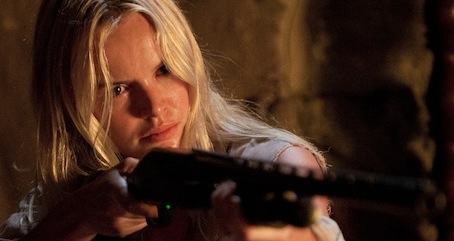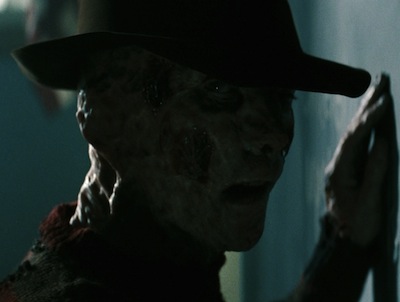Beware of minor spoilers for last weekend’s Straw Dogs below.
I saw the recent Straw Dogs remake—which hit theaters this past weekend—on a rainy night, with a packed theater and director Rod Lurie in attendance. Before the movie began, Lurie roused the theater by declaring that New York was “the best place to watch a movie.” I couldn’t disagree—and neither could the audience, who applauded the roof off as the lights dimmed and the picture flickered on screen.
 The movie is a solid retelling of its 1971 counterpart, a grim look at what happens when people are pushed to their limits and forced to act out violently. If you’ve read the reviews, you’re probably aware that James Marsden and Kate Bosworth play a couple who find themselves mentally tortured by the wife’s ex-boyfriend (Alexander Skarsgård). The tension between the trio escalates and, by the end, Skarsgård and his bully are delivered a bloody beating by an animalistic Marsden. In the original, these moments were terrifying, ugly and ambiguous—are our hero’s actions admirable or equally sick?—but the modernized version presents itself in a different light. When Marsden blasts a few bolts into an offenders hand with a nail gun or snaps a bear trap on Skarsgård’s head…the crowd doesn’t close their eyes and squirm. They go wild.
The movie is a solid retelling of its 1971 counterpart, a grim look at what happens when people are pushed to their limits and forced to act out violently. If you’ve read the reviews, you’re probably aware that James Marsden and Kate Bosworth play a couple who find themselves mentally tortured by the wife’s ex-boyfriend (Alexander Skarsgård). The tension between the trio escalates and, by the end, Skarsgård and his bully are delivered a bloody beating by an animalistic Marsden. In the original, these moments were terrifying, ugly and ambiguous—are our hero’s actions admirable or equally sick?—but the modernized version presents itself in a different light. When Marsden blasts a few bolts into an offenders hand with a nail gun or snaps a bear trap on Skarsgård’s head…the crowd doesn’t close their eyes and squirm. They go wild.
I admit, I found the experience disturbing. Straw Dogs isn’t Friday the 13th Part VIII: Jason Takes Manhattan—the movie paints its characters with realism, with flaws and with an instinctual thirst for carnage. In a moment where Skarsgård forcefully rapes Bosworth’s character, the movie demands to be taken seriously. Then, without warning, it goes into Home Alone-mode. I don’t believe this was a mistake. Straw Dogs asks us to root for James Marsden’s violent comeback—and that’s when things got weird. People seemed perfectly comfortable boarding that train.
My views of cinematic violence were forever shaken after watching Michael Haneke’s 1998 film Funny Games (which he remade shot-for-shot with Naomi Watts in 2007, for those who prefer English over German with subtitles). The movie plays like a warped version of your standard home invasion flick (think The Strangers), but with a set of rules that allow it to go from gritty realism to fourth-wall-breaking fantasy in a matter of seconds. The intruders are sadistic and brutal to the family they toy with, and while Haneke hints at the possibility that the mother, father, son trio have a chance of survival…they don’t.
 Throughout the film, the malicious duo makes reference to the fact that we’re watching a movie and that, perhaps, they should make the slaughtering of their victims more enjoyable for the audience. In one scene, Paul unties the mother, realizing it will “make things much more fun. The dumb suffer in unspectacular fashion.”
Throughout the film, the malicious duo makes reference to the fact that we’re watching a movie and that, perhaps, they should make the slaughtering of their victims more enjoyable for the audience. In one scene, Paul unties the mother, realizing it will “make things much more fun. The dumb suffer in unspectacular fashion.”
Haneke’s film is a clear comment on our enjoyment of on-screen violence, a reminder that the horrific acts we often cheer for, laugh at, gasp and giggle in shock over aren’t that far out of the realm of possibility. When that idea is planted in your head, it’s hard to shake—especially with recent movies gravitating towards realism.The recent remake of A Nightmare on Elm Street provided plenty of grounded backstory for Freddy (a child molester), who has a penchant for slicing up teenagers in their seemingly real dreams. And as bizarre as the premise of stitching people’s mouths to people’s anuses may sound, Human Centipede takes itself pretty darn seriously. The line between what’s horrific entertainment and what’s just plain horrifying has blurred. Oddly, it doesn’t seem to be fazing that many people.
Conversation over the depiction of violence has been going on for decades—every week there’s a new parents group pointing fingers and reminding us to think of the children. We often brush them off because they approach it with obnoxious damnation, but they’re not all wrong. Will there (or should there) ever be a line drawn? People didn’t question the sadistic outburst of James Marsden at the end of Straw Dogs—they applauded. Was this the “fun” kind of violence or has shock and terror lost all meaning?
 Witnessing violence on screen is important to understanding violence in the real world, but no longer does there seem to be a difference between cartoonish mayhem and grisly acts. I know that, sometime in the near future, I will see a silly horror movie involving an over-the-top serial killer with an oversized blade who lops off the heads of bubbly blondes and my reaction will be one of uproarious laughter as gallons of blood geyser out of their necks. That seems OK to me, because the movie acknowledges through performance, camera, music, etc. that the movie is ridiculous—like a live action Roadrunner and Coyote short. Unfortunately, Straw Dogs, like a lot of movies today, doesn’t see a difference. In turn, the audiences don’t either.
Witnessing violence on screen is important to understanding violence in the real world, but no longer does there seem to be a difference between cartoonish mayhem and grisly acts. I know that, sometime in the near future, I will see a silly horror movie involving an over-the-top serial killer with an oversized blade who lops off the heads of bubbly blondes and my reaction will be one of uproarious laughter as gallons of blood geyser out of their necks. That seems OK to me, because the movie acknowledges through performance, camera, music, etc. that the movie is ridiculous—like a live action Roadrunner and Coyote short. Unfortunately, Straw Dogs, like a lot of movies today, doesn’t see a difference. In turn, the audiences don’t either.
As I left the theater that night, the crowd was thoroughly jazzed. They loved the part where a guy got shot in the back of the head with a shotgun. I saw something similar that night on the local news.
You can contact Matt Patches directly on Twitter @misterpatches and remember to follow@Hollywood_com!



